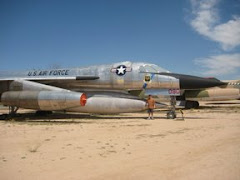The F-84's engine began life as the TG-180, later re-designated the J-35. The engine was 2,500 pounds, twelve feet long, and 37 and 1/2 inches in diameter. Early jet engines had short life spans, and often suffered failures. In 1948, the engine run-time between overhauls was 45 hours. Engine production delays hampered early F-84 production, seemingly as much from developmental issues as from a change in engine manufacturers. The engines used by the F-84C developed 4000 pounds of thrust.
The F-84C followed the "B" model. The last F-84C, #47-1602, rolled off the lines at Republic Aviation in December of 1948. The 191 "C" models had a "fly -away cost of $147,699.00" per ship. This was some $16,000 less than the previous "B" models.
The early models of the F-84 suffered from various structural problems and thus each airframe had a fairly short life expectancy. Coupled with the engine problems, this could sometimes be an insurmountable challenge to pilots.
First Lieutenant Harold A. Morris mounted his steed, #47-1602, the last "C" model off the Republic line, sometime after three in the afternoon of September 24, 1950, for a local flight from Geiger Field, Spokane, Washington. He was an Air National Guard pilot assigned to the 60th Fighter Wing. He was thirty years old.
Lt. Morris was on the wing of 1st Lt. Dallas P Sartz, flying in #47-1531 at about 15,000 feet. They were 8-10 minutes from Spokane and began a 180 degree turn to the left and entering intermittent light cloud formations when Lt. Morris crossed under Lt. Sartz. When he completed the turn, Sartz began calling for Morris with no response. Sartz landed at 1625 hours.
Mr. Garske, of Spokane, was coming from Odessa, Washington on the outskirts of Harrington, when he saw an airplane in a bank. The landing gear was down and it looked to Mr. Garske like the plane would land on the road. Then the pilot apparently changed his mind and made a 45 degree bank to attempt a landing in a field somewhat off the road. Mr. Garske saw, at just the moment of impact a "great big flash and flame and everything....It seemed to burn all at once, not a lingering fire." He jumped the fence and went to the wreck, which was about 300 yards from the road. When he got there, the engine was burning. Mr. Garske did not hear the engine before the crash, and claimed the aircraft was going very slowly.
Mr. Garske looked around the field to see if the pilot had been thrown free, but a couple of truck drivers who had also stopped said they had "found part of him." There were several witnesses, all of whom seem to have seen much the same thing.
The authorities determined the crash was due to a loss of power. The cause of the engine failure was undetermined because of the extent of damage. The remains of 1st Lt. Morris were described by the commanding colonel, Col. Neece, as tiny. He further noted that cause of death was due to "severe crushing injuries involving disintegration and cremation of the body."
The location is noted as being about 2 miles from Harrington, Washington. It was a ignoble end to the last F-84C built and a sad end to First Lieutenant Harold Albert Morris.*
* Resources for this article were as follows:
1. USAF accident report for F-84C #47-1602
2. McLaren, David R., Republic F-84; Tunderjet, Thunderstreak, & Thunderflash: A Photo Chronicle, Schiffer Military/Aviation History, Atglen, PA, 1998.







No comments:
Post a Comment